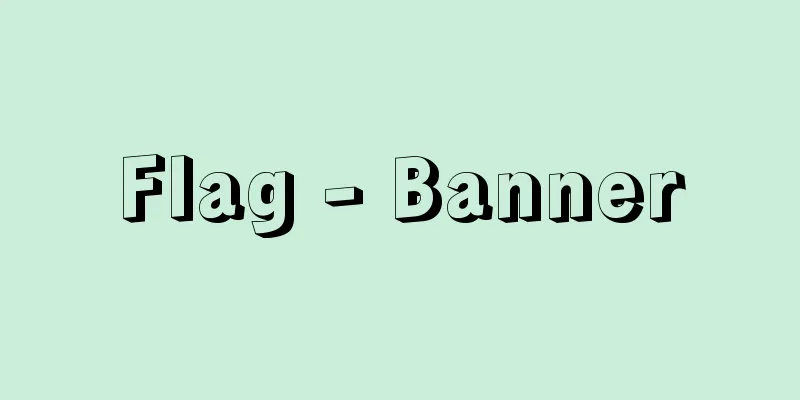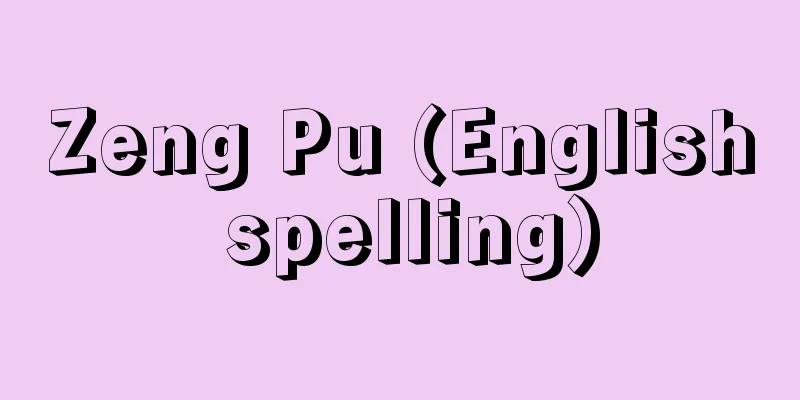Flag - Banner

|
A type of flag. In contrast to the so-called Nagare flag, an old-style flag with a horizontal top attached to the top edge and a cord attached to a flagpole, this flag has a wavy top and one vertical side attached to the top edge and two sides fixed by passing the pole. Nagare flags were invented because they were long and fluttering and got tangled up in bamboo and trees, which was inconvenient (Buyo Benryaku), but they were a way to make the patterns and designs of Nagare flags more visible, and as group battles developed, they became a form of flag that needed to clearly indicate military bases, ranks, and affiliations. The Nanpo Kiden states that in 1456 (Kōshō 2), during a war between the clans of Hatakeyama Masanaga and Yoshinari, it was difficult to tell friend from foe because both sides were using the same flag, so Masanaga attached a wavy top to his own Nagare flag and pushed it up through a pole, which is said to be the origin of the nobori, but there is no definite proof. The Sangi Itto Daisoushi has the word "hata no uchi" (flag milk), and the Nippo Jisho (Nippon-Portuguese Dictionary) (published in 1598) also lists "Nobori" as a flag used at military camps, so they must have been widespread in the late Middle Ages and the Warring States period. Therefore, the depictions of banners in military chronicles such as the Date Nikki, Mizusawa Gunki, Otomo Kouhaki, Azuchi Nikki, and Kiyomasa Ki, as well as in the Nagashino Kassen Zu byobu (Scaffolding of the Battle of Nagashino), Sekigahara Kassen Zu byobu (Scaffolding of the Battle of Sekigahara), and Osaka Natsu no Jin Zu byobu (Scaffolding of the Battle of Osaka), although created at a later date, are thought to tell us the actual situation from the Warring States period onwards. In general, the standard in the early modern period was to attach the horizontal handle near the top of the pole, attach a breast or a stuffed animal (a bag-shaped breast) to the top edge of the flag and to the left vertical side, stretch the flag over the pole, and attach a small flag called a maneki above the horizontal handle. These flags are also called breast-shaped flags or stuffed animal flags. Many flags such as large horse banners and flag-pointing items were in the form of nobori flags, and from the late Middle Ages to the early modern period, floating flags declined and disappeared from military camps. Thus, nobori flags became the standard for military camp flags, with designs that were simple, bold, and long, and many flags of the same design were lined up in one place to demonstrate the strength of one's troops, boost morale, and intimidate the enemy. Examples include the five flags of Takeda Shingen's grandson, five flags with the Takeda diamond crest, and the 20 all-white flags and seven crest flags of the Tokugawa Shogunate.In early modern times, military flags referred to banners. [Motoo Yamagishi] [Reference] |From the right, Tokugawa Ieyasu's flag, horse banner, Tokugawa Hidetada's flag, and large horse banner. "Goumajirushi" Volume 1, Kan'ei era (1624-1644), owned by the National Diet Library . Joinery and horse brand of Tokugawa Ieyasu and Tokugawa Hidetada Source: Shogakukan Encyclopedia Nipponica About Encyclopedia Nipponica Information | Legend |
|
旗の一種。古式の旗である長旗の上辺に横上(よこがみ)をつけ、緒を設けて旗竿(はたざお)に結び付けたいわゆる流(ながれ)旗に対し、上辺と縦の一辺に乳(ち)をつけ、竿を通して二辺を固定した形式の旗をさす。流旗は、長くなびき竹木に絡まって不便なため案出された(『武用弁略』)というが、長旗の文様、意匠がより顕示されるためのくふうであり、集団戦の発達とともに、その軍事拠点、階層、所属などを明示する必要に応じた旗の一形式である。『南方紀伝』に、1456年(康正2)、畠山政長(はたけやままさなが)、義就(よしなり)の同族の戦争のおり、両者同じ旗で敵味方の識別がむずかしいので、政長が自軍の流旗に乳をつけ、竿を通して押し立てたのが幟の起源とあるが、確証はない。『三儀一統大双紙』に「旗の乳」の語があり、『日葡(にっぽ)辞書』(1598刊)にも「Nobori」と立項され、軍陣所用の旗とあるので、中世末期、戦国時代には普及していたのであろう。したがって『伊達(だて)日記』『水沢軍記』『大友興廃記』『安土(あづち)日記』『清正(せいしょう)記』などの軍記類、『長篠(ながしの)合戦図屏風(びょうぶ)』『関ヶ原合戦図屏風』『大坂夏の陣図屏風』などにみえる幟の描写は、後代の成立ではあるが、ほぼ戦国時代以降の実状を物語るものと考えられる。一般には、横手を竿の上端近くにつけて、長旗の上辺と、縦の左側に乳または縫含(ぬいぐるみ)(袋乳(ふくろち))をつけて、竿を通して張り立て、横手の上に招(まねき)と称する小形の長旗をつけるのが近世の定形で、乳付の長旗、縫含旗とも称される。大馬印(おおうまじるし)、旗指物(はたさしもの)の類には幟旗形式が多く、中世末期から近世初頭以降、流旗は衰退して軍陣から姿を消してしまう。したがって、幟旗が軍陣の旗の定式となり、意匠は簡明、闊達(かったつ)、長大なものとなり、1か所に同意匠のものを多数そろえて林立せしめ、自軍の勢力を誇示し、士気を高揚するとともに敵を威嚇した。武田信玄(しんげん)の孫子の旗5張、武田菱(びし)の紋の旗5張、また、徳川将軍家の総白(そうじろ)の旗20張、紋の旗7張などはその例であって、近世、軍陣の旗とは幟をさすのである。 [山岸素夫] [参照項目] |右から、徳川家康の幟、馬印、徳川秀忠の幟、大馬印。『御馬印』 巻1 寛永年間(1624~1644)国立国会図書館所蔵"> 徳川家康、徳川秀忠の指物と馬印 出典 小学館 日本大百科全書(ニッポニカ)日本大百科全書(ニッポニカ)について 情報 | 凡例 |
Recommend
Coccidae
...A general term for insects in the order Hemipt...
Biography of a High Priest
This refers to a collection of biographies of Bud...
Walking race - Kyoho (English spelling) walking race
A type of athletics event. Athletes walk a certai...
Imo-tsuke - Imo-tsuke
…The basic techniques in joinery include hagite, ...
Round beak - Round beak (English spelling) scimitar babbler
A general term for birds of the genus Pomatorhinus...
Zhao
The name of a country in China during the Warring...
Large Hinano Usutsubo - Large Hinano Usutsubo
A perennial plant of the Scrophulariaceae family ...
Council of Ministers of the European Community - Council of Ministers of the European Community
…European Union [Tanaka Toshiro]. … *Some of the ...
Ust'-Polui culture
A culture from the 1st millennium BC in the Lower ...
Olmeca
...The similarity to the Chavin culture in the An...
Carbinol
Another name for methyl alcohol. The method of nam...
M2 - Emuni
…Currency means money in the narrow sense, but in...
American holly
...The Japanese name "hiiragi" (holly) ...
Omido (Mount Tsukuba) - Omido
...His character as the guardian deity of agricul...
Rainproofing - Amajimai
It is to prevent rainwater from entering a buildi...









